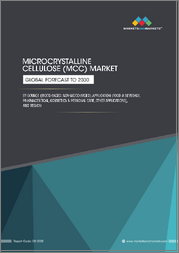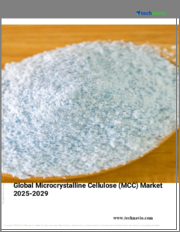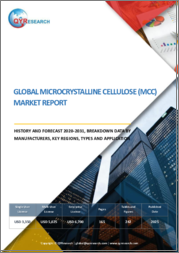
|
시장보고서
상품코드
1541195
세계의 미결정 셀룰로오스 시장 보고서 : 원료 유형, 합성 경로, 최종 사용자, 지역별(2024-2032년)Microcrystalline Cellulose Market Report by Source Type, Route of Synthesis, End User, and Region 2024-2032 |
||||||
미결정 셀룰로오스 시장 시장 규모는 2023년 12억 8,280만 달러에 달했습니다. 향후 IMARC Group은 시장이 2032년까지 19억 1,220만 달러에 이를 전망이며, 2024년과 2032년 사이에 4.4%의 복합 연간 성장률(CAGR)을 나타낼 것으로 예측했습니다.
미결정 셀룰로오스(MCC)는 결정성 폴리머 사슬의 짧은 정제/해중합 셀룰로오스를 말합니다. 충전제, 붕해제, 증량제, 바인더, 윤활제로 의약품 제제에 자주 사용됩니다. MCC는 고순도 목재 셀룰로오스 및 기타 섬유상 식물 원료의 제어된 부분 가수분해, 정제 및 건조에 의해 제조됩니다. 또한 반응성 압출, 효소를 통한 합성, 수증기 폭발, 산 가수분해를 사용하여 상업적으로 합성할 수 있습니다. 안정성 향상제 및 보조 현탁제로 작용합니다. 정제, 내복액, 약용 젤, 씹을 수 있는 정제나 구강내 용해정, 영양 보조 식품 등에 첨가되어 약물이나 영양소의 방출을 연장합니다.
미결정 셀룰로오스 시장 동향 :
세계의 제약 업계의 현저한 성장은 시장의 밝은 전망을 창출하는 중요한 요소 중 하나입니다. 게다가 음료의 제조에 MCC가 널리 채용되고 있는 것도 시장의 성장을 뒷받침하고 있습니다. MCC는 화학적으로 불활성이고 무미한 화합물이며, 냉동 요구르트, 휘핑 크림, 아이스크림과 같은 저지방 유제품의 제조에 사용됩니다. 고결방지제나 현탁화제, 안정제, 건강에 해로운 유지의 대체품으로서 널리 사용되어, 구운 제품에 바람직한 점성과 식감을 실현합니다. 게다가 3D 프린팅용 분해성 바이오 복합재료나 강화 폴리유산의 이용이 증가하고 있는 것도 성장을 가속하는 요인이 되고 있습니다. MCC는 인장강도와 열강도를 높여 폐기물과 전력소비를 최소화한 건축 및 건설부품의 3D조형용 첨가제로서 기능합니다. 기타 요인으로는 농업 폐기물을 사용하여 제조되는 비목재 기반 MCC에 대한 수요 증가와 광범위한 연구개발(R&D) 활동 등이 있어 시장 성장을 위한 원동력이 되면 예상됩니다.
이 보고서에서 다루는 주요 질문
- 2023년 세계의 미결정 셀룰로오스 시장 규모는?
- 2024년부터 2032년에 걸쳐 세계의 미결정 셀룰로오스 시장의 예상 성장률은?
- 세계의 미결정 셀룰로오스 시장을 견인하는 주요 요인은?
- 세계의 미결정 셀룰로오스 시장에 대한 COVID-19의 영향은?
- 세계의 미결정 셀룰로오스 시장의 소스 유형별 내역은?
- 합성 경로에 근거한 세계의 미결정 셀룰로오스 시장 내역은?
- 세계의 미결정 셀룰로오스 시장의 최종 사용자별 내역은?
- 미결정 셀룰로오스 시장의 주요 지역은?
- 세계의 미결정 셀룰로오스 시장의 주요 기업/기업은?
목차
제1장 서문
제2장 조사 범위와 조사 방법
- 조사의 목적
- 이해관계자
- 데이터 소스
- 1차 정보
- 2차 정보
- 시장 추정
- 상향식 접근
- 하향식 접근
- 조사 방법
제3장 주요 요약
제4장 소개
- 개요
- 주요 업계 동향
제5장 세계의 미결정 셀룰로오스 시장
- 시장 개요
- 시장 실적
- COVID-19의 영향
- 시장 예측
제6장 시장 내역 : 원료 유형별
- 목재 베이스
- 시장 동향
- 시장 예측
- 비목재 베이스
- 시장 동향
- 시장 예측
제7장 시장 내역: 합성 경로별
- 반응 압출
- 시장 동향
- 시장 예측
- 효소 매개
- 시장 동향
- 시장 예측
- 증기 폭발
- 시장 동향
- 시장 예측
- 산 가수분해
- 시장 동향
- 시장 예측
- 기계 연삭
- 시장 동향
- 시장 예측
- 초음파
- 시장 동향
- 시장 예측
제8장 시장 분석 : 최종사용자별
- 제약
- 시장 동향
- 시장 예측
- 음식
- 시장 동향
- 시장 예측
- 화장품 및 퍼스널케어
- 시장 동향
- 시장 예측
- 기타
- 시장 동향
- 시장 예측
제9장 시장 분석 : 지역별
- 북미
- 미국
- 캐나다
- 아시아태평양
- 중국
- 일본
- 인도
- 한국
- 호주
- 인도네시아
- 기타
- 유럽
- 독일
- 프랑스
- 영국
- 이탈리아
- 스페인
- 러시아
- 기타
- 라틴아메리카
- 브라질
- 멕시코
- 기타
- 중동 및 아프리카
- 시장 동향
- 시장 분석 : 국가별
- 시장 예측
제10장 SWOT 분석
- 개요
- 강점
- 약점
- 기회
- 위협
제11장 밸류체인 분석
제12장 Porter's Five Forces 분석
- 개요
- 구매자의 협상력
- 공급기업의 협상력
- 경쟁도
- 신규 진입업자의 위협
- 대체품의 위협
제13장 가격 분석
제14장 경쟁 구도
- 시장 구조
- 주요 기업
- 주요 기업 프로파일
- Accent Microcell Pvt. Ltd.
- Asahi Kasei Corporation
- Chemfield Cellulose
- DFE Pharma GmbH & Co. KG(Royal FrieslandCampina NV)
- DuPont de Nemours Inc
- Huzhou City Linghu Xinwang Chemical Co., Ltd
- JRS PHARMA GmbH & Co. KG
- Mingtai Chemical Co Ltd.
- Rayonier Advanced Materials
- Roquette Freres
- Sigachi Industries
The global microcrystalline cellulose market size reached US$ 1,282.8 Million in 2023. Looking forward, IMARC Group expects the market to reach US$ 1,912.2 Million by 2032, exhibiting a growth rate (CAGR) of 4.4% during 2024-2032.
Microcrystalline cellulose (MCC) refers to purified and depolymerized cellulose with shorter crystalline polymer chains. It is commonly used as a filler, disintegrant and bulking, binding, lubricating agent in drug formulations. MCC is manufactured through controlled partial hydrolysis, purification and drying of high purity wood cellulose and other fibrous plant material. It can also be commercially synthesized using reactive extrusion, enzyme-mediated synthesis, steam explosion and acid hydrolysis. It acts as a stability enhancer and auxiliary suspending agent. It is added to tablets, oral fluids, medicinal gels and chewable and mouth dissolving tablets and nutraceuticals for prolonged drug and nutrient release.
Microcrystalline Cellulose Market Trends:
Significant growth in the pharmaceutical industry across the globe is one of the key factors creating a positive outlook for the market. Moreover, the widespread adoption of MCC in the manufacturing of food and beverage products is providing a thrust to the market growth. MCC is a chemically inert and tasteless compound, which is used to produce low-fat dairy products, such as frozen yogurt, whipped cream and ice cream. It is extensively used as an anti-caking and suspending agent, stabilizer and a substitute for unhealthy fats and oils to achieve the desired consistency and texture in baked products. Additionally, the increasing utilization of degradable bio-composites and reinforced polylactic acid for 3D printing is acting as another growth-inducing factor. MCC acts as an additive for the 3D fabrication of building and construction components with enhanced tensile and thermal strength and minimal waste and power consumption. Other factors, including the increasing demand for non-wood-based MCC manufactured using agricultural waste, along with extensive research and development (R&D) activities, are anticipated to drive the market toward growth.
Key Market Segmentation:
IMARC Group provides an analysis of the key trends in each sub-segment of the global microcrystalline cellulose market report, along with forecasts at the global, regional and country level from 2024-2032. Our report has categorized the market based on source type, route of synthesis and end user.
Breakup by Source Type:
Wood-based
Non-wood based
Breakup by Route of Synthesis:
Reactive Extrusion
Enzyme Mediated
Steam Explosion
Acid Hydrolysis
Mechanical Grinding
Ultrasonication
Breakup by End User:
Pharmaceutical
Food and Beverages
Cosmetics and Personal Care
Others
Breakup by Region:
North America
United States
Canada
Asia-Pacific
China
Japan
India
South Korea
Australia
Indonesia
Others
Europe
Germany
France
United Kingdom
Italy
Spain
Russia
Others
Latin America
Brazil
Mexico
Others
Middle East and Africa
Competitive Landscape:
The competitive landscape of the industry has also been examined along with the profiles of the key players being Accent Microcell Pvt. Ltd., Asahi Kasei Corporation, Chemfield Cellulose, DFE Pharma GmbH & Co. KG (Royal FrieslandCampina N.V.), DuPont de Nemours Inc, Huzhou City Linghu Xinwang Chemical Co., Ltd, JRS PHARMA GmbH & Co. KG, Mingtai Chemical Co Ltd., Rayonier Advanced Materials, Roquette Freres and Sigachi Industries.
Key Questions Answered in This Report
- 1. What was the size of the global microcrystalline cellulose market in 2023?
- 2. What is the expected growth rate of the global microcrystalline cellulose market during 2024-2032?
- 3. What are the key factors driving the global microcrystalline cellulose market?
- 4. What has been the impact of COVID-19 on the global microcrystalline cellulose market?
- 5. What is the breakup of the global microcrystalline cellulose market based on the source type?
- 6. What is the breakup of the global microcrystalline cellulose market based on the route of synthesis?
- 7. What is the breakup of the global microcrystalline cellulose market based on the end user?
- 8. What are the key regions in the global microcrystalline cellulose market?
- 9. Who are the key players/companies in the global microcrystalline cellulose market?
Table of Contents
1 Preface
2 Scope and Methodology
- 2.1 Objectives of the Study
- 2.2 Stakeholders
- 2.3 Data Sources
- 2.3.1 Primary Sources
- 2.3.2 Secondary Sources
- 2.4 Market Estimation
- 2.4.1 Bottom-Up Approach
- 2.4.2 Top-Down Approach
- 2.5 Forecasting Methodology
3 Executive Summary
4 Introduction
- 4.1 Overview
- 4.2 Key Industry Trends
5 Global Microcrystalline Cellulose Market
- 5.1 Market Overview
- 5.2 Market Performance
- 5.3 Impact of COVID-19
- 5.4 Market Forecast
6 Market Breakup by Source Type
- 6.1 Wood-based
- 6.1.1 Market Trends
- 6.1.2 Market Forecast
- 6.2 Non-wood based
- 6.2.1 Market Trends
- 6.2.2 Market Forecast
7 Market Breakup by Route of Synthesis
- 7.1 Reactive Extrusion
- 7.1.1 Market Trends
- 7.1.2 Market Forecast
- 7.2 Enzyme Mediated
- 7.2.1 Market Trends
- 7.2.2 Market Forecast
- 7.3 Steam Explosion
- 7.3.1 Market Trends
- 7.3.2 Market Forecast
- 7.4 Acid Hydrolysis
- 7.4.1 Market Trends
- 7.4.2 Market Forecast
- 7.5 Mechanical Grinding
- 7.5.1 Market Trends
- 7.5.2 Market Forecast
- 7.6 Ultrasonication
- 7.6.1 Market Trends
- 7.6.2 Market Forecast
8 Market Breakup by End User
- 8.1 Pharmaceutical
- 8.1.1 Market Trends
- 8.1.2 Market Forecast
- 8.2 Food and Beverages
- 8.2.1 Market Trends
- 8.2.2 Market Forecast
- 8.3 Cosmetics and Personal Care
- 8.3.1 Market Trends
- 8.3.2 Market Forecast
- 8.4 Others
- 8.4.1 Market Trends
- 8.4.2 Market Forecast
9 Market Breakup by Region
- 9.1 North America
- 9.1.1 United States
- 9.1.1.1 Market Trends
- 9.1.1.2 Market Forecast
- 9.1.2 Canada
- 9.1.2.1 Market Trends
- 9.1.2.2 Market Forecast
- 9.1.1 United States
- 9.2 Asia-Pacific
- 9.2.1 China
- 9.2.1.1 Market Trends
- 9.2.1.2 Market Forecast
- 9.2.2 Japan
- 9.2.2.1 Market Trends
- 9.2.2.2 Market Forecast
- 9.2.3 India
- 9.2.3.1 Market Trends
- 9.2.3.2 Market Forecast
- 9.2.4 South Korea
- 9.2.4.1 Market Trends
- 9.2.4.2 Market Forecast
- 9.2.5 Australia
- 9.2.5.1 Market Trends
- 9.2.5.2 Market Forecast
- 9.2.6 Indonesia
- 9.2.6.1 Market Trends
- 9.2.6.2 Market Forecast
- 9.2.7 Others
- 9.2.7.1 Market Trends
- 9.2.7.2 Market Forecast
- 9.2.1 China
- 9.3 Europe
- 9.3.1 Germany
- 9.3.1.1 Market Trends
- 9.3.1.2 Market Forecast
- 9.3.2 France
- 9.3.2.1 Market Trends
- 9.3.2.2 Market Forecast
- 9.3.3 United Kingdom
- 9.3.3.1 Market Trends
- 9.3.3.2 Market Forecast
- 9.3.4 Italy
- 9.3.4.1 Market Trends
- 9.3.4.2 Market Forecast
- 9.3.5 Spain
- 9.3.5.1 Market Trends
- 9.3.5.2 Market Forecast
- 9.3.6 Russia
- 9.3.6.1 Market Trends
- 9.3.6.2 Market Forecast
- 9.3.7 Others
- 9.3.7.1 Market Trends
- 9.3.7.2 Market Forecast
- 9.3.1 Germany
- 9.4 Latin America
- 9.4.1 Brazil
- 9.4.1.1 Market Trends
- 9.4.1.2 Market Forecast
- 9.4.2 Mexico
- 9.4.2.1 Market Trends
- 9.4.2.2 Market Forecast
- 9.4.3 Others
- 9.4.3.1 Market Trends
- 9.4.3.2 Market Forecast
- 9.4.1 Brazil
- 9.5 Middle East and Africa
- 9.5.1 Market Trends
- 9.5.2 Market Breakup by Country
- 9.5.3 Market Forecast
10 SWOT Analysis
- 10.1 Overview
- 10.2 Strengths
- 10.3 Weaknesses
- 10.4 Opportunities
- 10.5 Threats
11 Value Chain Analysis
12 Porters Five Forces Analysis
- 12.1 Overview
- 12.2 Bargaining Power of Buyers
- 12.3 Bargaining Power of Suppliers
- 12.4 Degree of Competition
- 12.5 Threat of New Entrants
- 12.6 Threat of Substitutes
13 Price Analysis
14 Competitive Landscape
- 14.1 Market Structure
- 14.2 Key Players
- 14.3 Profiles of Key Players
- 14.3.1 Accent Microcell Pvt. Ltd.
- 14.3.1.1 Company Overview
- 14.3.1.2 Product Portfolio
- 14.3.2 Asahi Kasei Corporation
- 14.3.2.1 Company Overview
- 14.3.2.2 Product Portfolio
- 14.3.2.3 Financials
- 14.3.2.4 SWOT Analysis
- 14.3.3 Chemfield Cellulose
- 14.3.3.1 Company Overview
- 14.3.3.2 Product Portfolio
- 14.3.4 DFE Pharma GmbH & Co. KG (Royal FrieslandCampina N.V.)
- 14.3.4.1 Company Overview
- 14.3.4.2 Product Portfolio
- 14.3.5 DuPont de Nemours Inc
- 14.3.5.1 Company Overview
- 14.3.5.2 Product Portfolio
- 14.3.5.3 Financials
- 14.3.5.4 SWOT Analysis
- 14.3.6 Huzhou City Linghu Xinwang Chemical Co., Ltd
- 14.3.6.1 Company Overview
- 14.3.6.2 Product Portfolio
- 14.3.7 JRS PHARMA GmbH & Co. KG
- 14.3.7.1 Company Overview
- 14.3.7.2 Product Portfolio
- 14.3.8 Mingtai Chemical Co Ltd.
- 14.3.8.1 Company Overview
- 14.3.8.2 Product Portfolio
- 14.3.9 Rayonier Advanced Materials
- 14.3.9.1 Company Overview
- 14.3.9.2 Product Portfolio
- 14.3.9.3 Financials
- 14.3.10 Roquette Freres
- 14.3.10.1 Company Overview
- 14.3.10.2 Product Portfolio
- 14.3.10.3 SWOT Analysis
- 14.3.11 Sigachi Industries
- 14.3.11.1 Company Overview
- 14.3.11.2 Product Portfolio
- 14.3.1 Accent Microcell Pvt. Ltd.



















